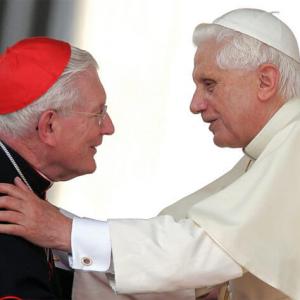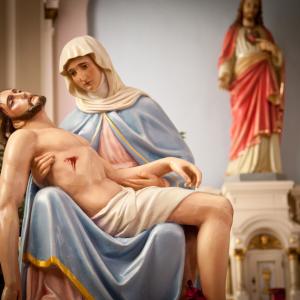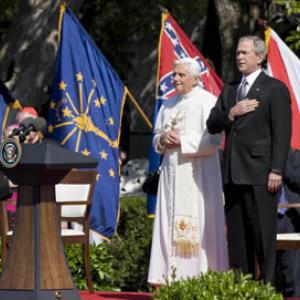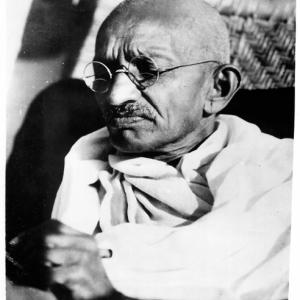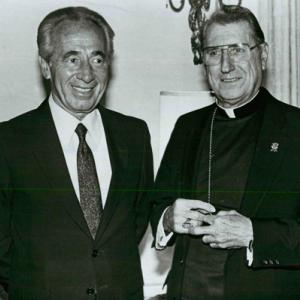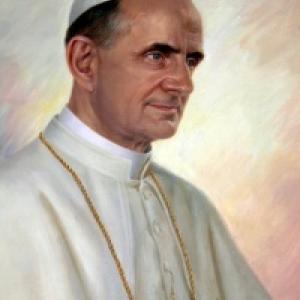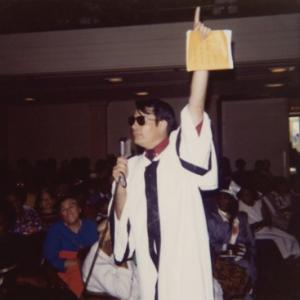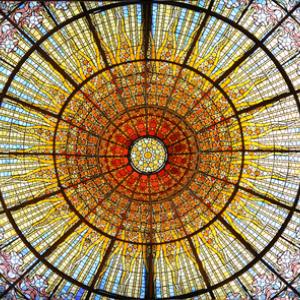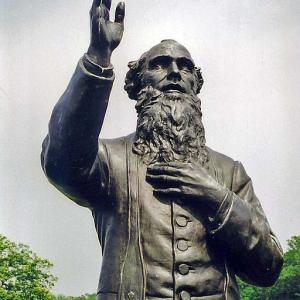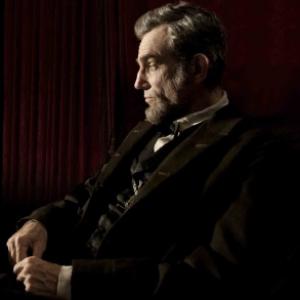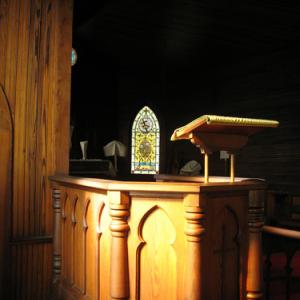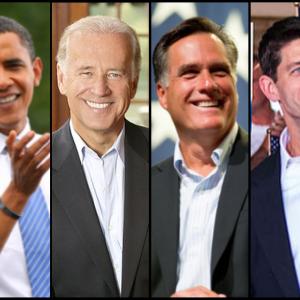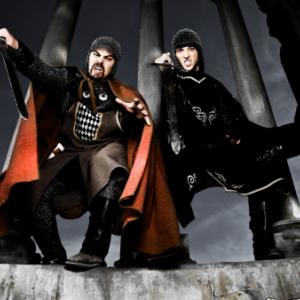Rabbi A. James Rudin, the American Jewish Committee's senior interreligious adviser, is the author of the recent book, Cushing, Spellman, O'Connor: The Surprising Story of How Three American Cardinals Transformed Catholic-Jewish Relations.
Posts By This Author
The Hatred in Charlottesville Should Not Surprise Us
The crowd that night believed something precious had been “stolen” from them as Christians. And it had to be “reclaimed.”
That long ago bitter sermon provides a warning as Americans ponder this question: Was the lethal violence in Charlottesville a one-time event, or does it represent the future of an America religiously and politically at war with itself?
Cardinal William Keeler Was a Bridge-Builder, and a Dear Friend
During our nearly 40 years of friendship, I led several interreligious missions with Keeler, including meetings with then-Pope John Paul II at the Vatican. We co-led trips to Israel, including a visit to a civilian bomb shelter, and a poignant painful pilgrimage to the infamous death camps of Auschwitz-Birkenau.
Sometimes public figures can seem distant and impersonal, but that was never the case with the always gracious and welcoming Keeler.
The Dangerous Perversion of Religion and Politics

Image via Gage Skidmore/flickr.com
A decade ago, a critic accused me of writing a book about a “nonexistent” threat from the religious right. One reviewer called my work a “paranoid rant,” while another detractor wrote my “alarmist” views were “exaggerated and implausible.”
In The Baptizing of America: The Religious Right’s Plans For The Rest Of Us, published in 2006, I had warned that a well-financed and highly organized group of religious and political leaders was seeking to impose their narrow extremist beliefs and harsh public policies on the United States, even as our nation’s population was increasingly multireligious, multiethnic, and multiracial.
How the Catholic Church Transformed Its Relationship With Jews

Image via iravgustin/Shutterstock.com
My rabbinic colleague, David Saperstein, the U.S. ambassador-at-large for international religious freedom, issued a “glass half full” report earlier this month, noting that “… over the last several years there’s been a steady increase in the percentage of people who live in countries that … have serious restrictions on religious freedom.”
At the same time, he noted, “we’ve seen enormous expansion of interfaith efforts on almost every continent to try and address the challenges.”
Much of that “enormous expansion of interfaith efforts” can be traced to the historic Nostra Aetate (Latin for “In Our Time”) Declaration that the world’s Catholic bishops adopted 50 years ago at the conclusion of the Second Vatican Council.
Pining for 1950s Religiosity and Missing the Bigger Picture
State Sen. Sylvia Allen, R-Ariz., wins the top prize for this year’s silliest religious idea so far.
While debating a proposed law that would permit people to carry concealed weapons in public buildings, Allen said, “Probably we should be debating a bill requiring every American to attend a church of their choice on Sunday to see if we can get back to having a moral rebirth.”
Although the senator said it was a “flippant” suggestion, she remained unapologetic for her comments on “the moral erosion of the soul of America.”
Let's Drop the Antisemitic Messages this Good Friday
This year, Good Friday and the start of Passover occur on the same date: Friday, April 3. The coincidence is no accident.
Jesus’ pilgrimage to Jerusalem to celebrate the eight-day Jewish festival marking the Hebrew slaves’ exodus from Egyptian slavery was a religious requirement for Jews of his day. After his death by Roman crucifixion, Passover became an integral part of the Easter story, and Jesus’ Last Supper was like an early version of what later became the Passover seder meal.
In past years, I anonymously attended Good Friday services in New York and sat alongside Christians as they commemorated the death of Jesus as recounted in the New Testament Gospel of John. I alternated each year between Roman Catholic and Protestant churches because I was interested in how preachers handled John’s 71 references to the Jewish people, a text that’s often called “radioactive” because of its negative teaching about Jews and their alleged culpability in killing Jesus.
I attend the most solemn Christian service of the year knowing it had often been a day of dread and even death for many European Jewish communities.
Pope Francis and America’s Shifting Views Toward Catholics
Did you catch the shoutout to Pope Francis during President Obama’s State of the Union address? It’s only the third time in history that’s happened.
Francis’ name will resurface in Congress later this year if and when he accepts an invitation to address lawmakers — that would be a historical first — during his September trip to Philadelphia, Washington, and New York.
“We might say, really, the highlight of the Washington visit might be his speech to the joint meeting of Congress, to the Senate and the House of Representatives,” said Archbishop Bernardito Auza, a member of the papal visit planning committee.
However, such a speech will be far more than a “highlight.” With a Catholic vice president and a Catholic speaker of the House looking on behind him, the speech will serve as a vivid reminder of how far Americans have come in overcoming deeply embedded anti-Catholic prejudice and bigotry.
That bigotry includes Thomas Jefferson, who wrote in 1813: “History, I believe, furnishes no example of a priest-ridden people maintaining a free civil government. … In every country and in every age, the priest has been hostile to liberty.”
Is Nonviolence a Solution to All the World’s Conflicts?
Mention the concept of “nonviolent resistance” and two names immediately come to mind: Mahatma Gandhi, the Indian leader who led his nation to independence from British colonial rule, and Martin Luther King Jr., who led the struggle for civil rights in America. Tragically, both champions of nonviolence were assassinated: Gandhi in 1948 and King 20 years later. Today many people throughout the world revere both advocates of nonviolence.
While Gandhi and King were largely successful in their efforts, the question remains whether nonviolent resistance is always the most effective strategy in the face of radical evil, injustice, and aggression. After all, there remains a thin line between nonviolence and martyrdom.
Professor Charles DiSalvo of West Virginia University has recently published “M.K. Gandhi, Attorney at Law: The Man Before the Mahatma,” an excellent study of Gandhi’s 20 years as a young attorney in South Africa where he faced anti-Indian stereotyping and bigotry.
Interestingly, Gandhi’s two closest friends were Jews he knew in Durban and Johannesburg. But despite Gandhi’s personal friendships and his commitment to freedom and security for his own people, he was indifferent, at best, or naive, about the Nazi persecution of Jews.
COMMENTARY: Cardinal John O'Connor Would Have Made a Great Rabbi
In April 1908, Dorothy Gumple, a 19-year-old Jewish woman living in Connecticut, converted to Roman Catholicism. Less than two years, later she married a Catholic immigrant from Ireland. They and their five children lived in Philadelphia where her husband was a lifelong trade union member. It is not exactly the stuff global news stories are made of.
Except this: Their fourth child became the world-famous archbishop of New York, Cardinal John J. O’Connor, who served in that position from 1984 until his death in 2000.
It’s Time to Open the Wartime Pope’s Records
It’s almost a year since Pope Francis was chosen as Benedict XVI’s successor. The Argentinian-born pontiff has quickly achieved global fame for his numerous statements indicating that significant changes may be coming to the Roman Catholic Church.
One possible change emerged last month when London’s Sunday Times reported that Francis wants to make public the Vatican’s archives of Pius XII’s pontificate. Eugenio Pacelli became pope in 1939 and served as pontiff during the period of World War II and the Holocaust until his death in 1958.
According to the British newspaper, Francis wants to release the Pius XII papers for study before determining whether to consider his controversial predecessor for sainthood. Francis has already “fast-tracked” the path to sainthood for John XXIII and John Paul II, but not Pius XII.
35 Years After Jonestown
It’s been 35 years since 918 people, including 257 children, died on Nov. 18, 1978, at the Peoples Temple massacre in Jonestown. The mass murder inside the South American jungle commune in Guyana was engineered by Jim Jones, a murderous cult leader, and was the only time in American history a member of Congress, Leo Ryan, D-Calif., was killed in the line of official duty.
Most of the victims were forced to commit suicide by drinking a fatal cocktail of poisoned punch spiked with a Valium tranquilizer. In the days that followed the slaughter of the innocents, Jonestown became a widely reported global event whose media coverage rivaled that of the Japanese attack on Pearl Harbor.
As a result of the massacre, “drinking the Kool-Aid” entered the popular lexicon to describe blind acceptance of a belief without critical analysis. Some of the Jonestown dead were not suicides; they were killed against their will, and the actual drink of death was, in fact, something called Flavor Aid.
The Persistent Stained-Glass Ceiling
More than 40 years have passed since Sally Priesand was ordained as the first female rabbi in the U.S. Since then, more than 800 female rabbis — including 647 in the Reform movement — have graduated from several seminaries, including my daughter Eve.
Even so, Jewish and Christian clergywomen still face visible and invisible obstacles in their careers. Call it the persistent stained-glass ceiling. Some barriers are major in nature; some minor.
A male rabbi, minister or priest might be praised for being “assertive” and “ambitious” as he climbs the slippery ladder of success in American religious life. But women who possess similar qualities are dubbed “brash” or “arrogant.” Male clergy can be “dynamic,” while women with the same qualities are often termed “strident.”
God Didn’t Choose Sides at Gettysburg
During the July 1-3, 1863 Battle of Gettysburg, there were Christians and Jews on both sides of the conflict who knew the answer to the question “Whose side is God on?”
Or at least they thought they did.
In 1861, Confederate President Jefferson Davis declared: “Our cause is just and holy,” and the South self-assuredly adopted as its motto Deo vindice (“God will vindicate us”). In the same year, Julia Ward Howe composed the “Battle Hymn of the Republic” with the triumphant words: “He hath loosed the fateful lightning of His terrible swift sword. … I have seen Him in the watch-fires of a hundred circling camps. … Glory, glory Hallelujah, His truth is marching on.”
Father Abraham and the Jews
Steven Spielberg’s Lincoln will probably nab a few of its 12 nominated Academy Awards when the Oscars are handed out on Sunday — a sign that Americans never have and probably never will tire of our 16th president.
Abraham Lincoln’s face is etched in stone on Mount Rushmore and his brooding statue sits enshrined in a Greek-style temple in Washington. His succinct Gettysburg Address (about 270 words) took all of about two minutes to deliver, yet remains this nation’s most famous speech 150 years later. His assassination lifted him to mythic status — a martyr who earned his place in our pantheon of national heroes.
We just marked the 150th anniversary of his Emancipation Proclamation, but that necessary action wasn’t enough. Spielberg’s film revives Lincoln’s second act, in 1865, to pass the Thirteenth Amendment to abolish slavery through a divided Congress. It wasn’t the only injustice Lincoln worked to correct.
In his recent book, When General Grant Expelled the Jews, Brandeis University Professor Jonathan D. Sarna recounts an important but little-known event in 1863 in Lincoln’s quest for full civil, religious, and human rights for all Americans — this time, for American Jews.
Ancient Wisdom for 21st Century Problems
In an attempt to make sense of the 2012 election and the unfolding David Petraeus sex scandal, I consulted the Bible and the Sayings of the Fathers, a collection of sage rabbinic teachings written between 200 B.C. and 200 A.D.
Turns out the ancient perceptions about politics and ethics are as insightful today as when they were first uttered.
I am appalled when clergy of any religion endorse candidates by name in the run-up to an election. Priests, ministers, rabbis and imams, of course, have every right to vote for any particular person they choose, thanks to the secret ballot. The clergy also have the right — indeed, the obligation — to discuss and debate the critical issues facing society. But religious leaders err and undermine their own authority when they publicly call for the election or defeat of a specific individual.
Last month “Pulpit Freedom Sunday” was sponsored by a group called the Alliance Defending Freedom. Nearly 1,500 Christian ministers openly backed various candidates as they tested the U.S. tax code, which forbids non-profit organizations (including houses of worship) from speaking out for or against political candidates. Such actions endanger their tax-exempt status, but the ADF sees that restriction as an incursion on freedom of religion and speech.
Of Protestants, Politics, and Power
As the Republicans leave Tampa and the Democrats prepare to gather in Charlotte, one dynamic is immediately clear in both parties: For the first time since Abraham Lincoln ran in 1860, no white Protestant will be on the ticket of either major party.
Mitt Romney, the newly minted Republican nominee for the White House, is a Mormon, though he clearly does not want to talk publicly about how his faith shapes his identity and personal values. Paul Ryan, his running mate, is a Catholic, a fact Romney made sure to mention in the vice presidential rollout ceremony. Indeed, Romney’s two closest rivals in the GOP presidential primaries were also Catholics: Newt Gingrich and Rick Santorum.
On the Democratic side, President Obama is an African-American Protestant despite the fetid conspiratorial screams that the president is a crypto-Muslim. Finally, Vice President Joe Biden, like Ryan, is an Irish-American Catholic.
Pride Goeth Before a Sail
Word to the wise: don't get on a cruise ship in a year ending in the number 12. Especially if the captain feels a little too sure of himself.
Earlier this year the world was captivated by images of the Costa Concordia capsized off the Italian coast. The captain allegedly ignored the navigation maps, ran aground and at least 30 people died as a result.
April 12 marks the 100th anniversary of the disaster of the Titanic, which sank about 360 miles from Newfoundland when the famously "unsinkable" ship hit an ice berg. Three hours later, it was an underwater grave two miles below the frigid surface of the North Atlantic.
They're Baaa-aaack: Return of the Christocrats (Who Never Really Went Away)
The Democratic sweep of Congress in 2006 and President Obama's election in 2008 convinced many people the religious right had been defeated and discredited. They believed it was time to "move on," a ubiquitous but dangerous phrase that often blinds people to unpleasant realities.
The truth, however, is that the religious right, Christian Reconstructionism and Dominionism have never gone away. And now they're back — "big time," as Dick Cheney might say.
In the 2012 presidential election, the Christocrats are out in force on many fronts: trying to eliminate prenatal care and all forms of contraception; defunding breast cancer screening; opposing civil rights for same-sex couples; contesting evolution and substituting creationism in public schools; denying the reality of global climate change; and discrediting the "lame stream media."

